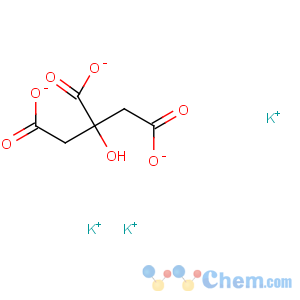Title: Potassium Citrate
CAS Registry Number: 866-84-2
CAS Name: 2-Hydroxy-1,2,3-propanetricarboxylic acid tripotassium salt
Synonyms: tripotassium citrate
Molecular Formula: C6H5K3O7
Molecular Weight: 306.39
Percent Composition: C 23.52%, H 1.64%, K 38.28%, O 36.55%
Line Formula: K3C6H5O7
Literature References: Manufacturing process: G. Kominek,
US 3819696 (1974 to Jungbunzlauer). Effect on urinary chemistry and crystallization of stone forming salts: K. Sakhaee
et al., Kidney Int. 24, 348 (1983). Use in oral rehydration solutions: M. R. Islam,
Arch. Dis. Child. 60, 852 (1985). Clinical trial in nephrolithiasis: C. Y. C. Pak
et al., J. Urol. 134, 11 (1985); following shockwave lithotripsy: T. Soygür
et al., J. Endourol. 16, 149 (2002).
Derivative Type: Monohydrate
CAS Registry Number: 6100-05-6
Trademarks: K-CIT-V (V.E.T.); Urocit-K (Mission Pharmacal)
Molecular Formula: C6H5K3O7.H2O
Molecular Weight: 324.41
Percent Composition: C 22.21%, H 2.17%, K 36.16%, O 39.45%
Properties: White crystals, granules or powder; odorless with cooling, salty taste. Loses its water at 180°. One gram dissolves in 0.65 ml water; very slowly in 2.5 ml glycerol. Practically insol in alcohol. The aq soln is alkaline to litmus; pH about 8.5.
Use: In foods and beverages as buffering, sequestering or emulsifying agent.
Therap-Cat: Alkalinizing agent; antiurolithic.
Therap-Cat-Vet: Alkalinizing agent; antiurolithic.
Keywords: Alkalinizing Agent; Antiurolithic.

